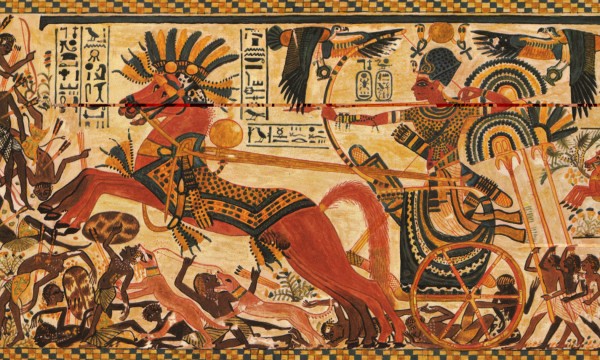At least that’s what Egyptologist Chris Naunton of the Egypt Exploration Society concluded, after examining tissues of the dead pharaoh. Ever since Tutankhamun was excavated in 1923, the question how and why the pharaoh died has been unanswered. Naunton isn’t the first to think to know how Tutankhamun’s life ended: Lots of scenarios were suggested during the decades, from epilepsy to a nasty fall and malaria. All these theories were eventually rejected as new research suggested another solution. But Naunton thinks his view will stand the test of time. The conclusions of the examination are shown in a documentary ‘Tutankhamun: The Mystery of the Burnt Mummy‘ aired next sunday by the British broadcaster Channel 4 – but a longer version of the documentary is already online (scroll down & view).
Tutankhamun: Death by chariot
Naunton used CT-scans and X-rays on the mummy’s pharaoh and he discovered that the young pharaoh had a number of major injuries on the one side of his body, like you would with a chariot accident. To proof this as a possibility, a reconstruction was made. And indeed, the pharaoh’s wounds were similar to wounds that would be inflicted during an accident. Naunton states that this would also explain why the pharaoh was buried without heart: the heart was so badly damaged that it was beyond saving.
Not a pleasant start of the afterlife: Tutankhamun’s mummy spontaneous combusted
As Naunton researched the notes made by Henri Carter (1874-1939) during the discovery of Tutankhamun’s tomb in 1923, he found evidence that suggested that the body of the young pharaoh was burned. To find out if that was true, Naunton examined blood-tissues that researchers took from the pharaoh in 1968. He used the latest chemical research-techniques on these tissues. Conclusion: As the mummy was already in his sealed coffin, it spontaneously combusted, as a result of a chemical reaction of the embalming-oils.
Naunton’s teleological approach is not convincing
It has to be seen if Naunton’s theory will stand the test of time. The available data aren’t convincing (to me at least). The chariot accident is a nice suggestion, but the research is purely teleological. First there was a theory, and all the historical evidence is interpreted in support of this theory. The chariot accident is a foregone conclusion as the wounds of the pharaoh could be inflicted on many ways. Moreover, the wounds don’t prove why Tutankhamun’s heart wasn’t buried with him. Even a badly damaged hearts was seen by the Egyptians as the emotional and intellectual center of the human being. Therefore, mummy’s are always buried with their heart (although other organs were removed). The spontaneous combustion is a creative suggestion as well, but if so, I wonder why all the other mummies didn’t spontaneously combust.
The documentary that’s aired coming sunday most likely is an excerpt of the documentary below – watch and judge for yourself.

Leave a Reply